Saturday, 22 May 2010
Distance 15 km
Duration 3 hours 0 minutes
Ascent 58 m, descent 52 m
Map 27 of the TOP100 blue series (or Map 135 in the new lime-green series)
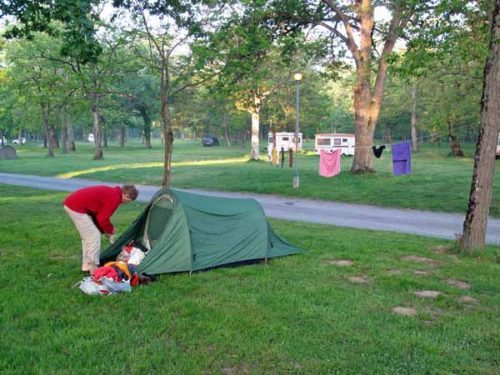
During the night, Keith’s air mattress let him down twice, having mysteriously developed a leak since last year. I had no risk of such a thing, as my mattress was non-inflatable.
In the morning we crawled out of the tent into a heavy dew, which required us to carry everything across to the reception building where there were tables and chairs on a gravel terrace. Nobody else seemed to be awake, and we ate our muesli comfortably, a few steps from the quiet river.
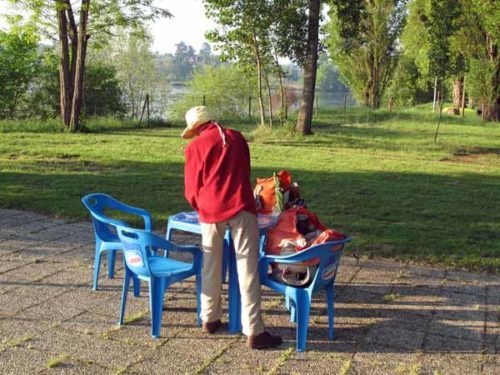
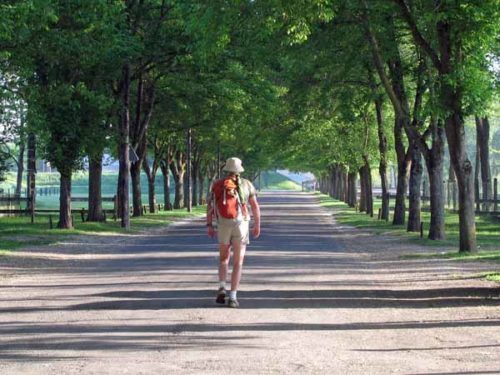
It was about 8 o’clock when we left. As we joined the main road and started over the second bridge, big signs told us that we were crossing into the department of Cher (from Nièvre), and at the same time into the region of Centre (from Bourgogne).
Once off the bridge, we turned left on a cycle path along the top of a levee bank.
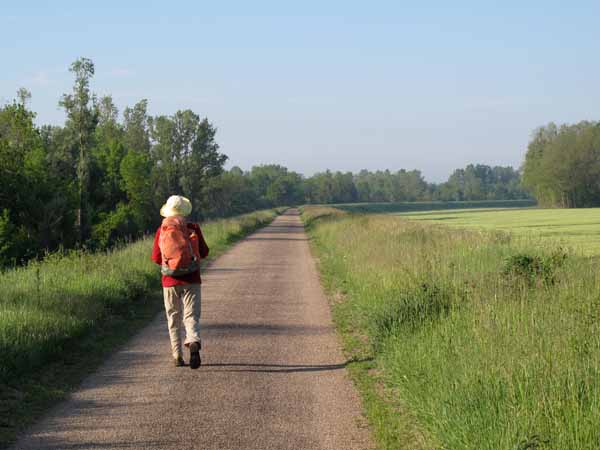
It would have been a delightful walk, with the river on one side and the fields on the other, but I soon noticed a swishing noise as I walked – the heel of my beloved old walking shoes, carefully repaired before we left home and having shown no sign of weakness in several trial wearings, was coming loose.
An hour later, when we got to Bannay (under the railway line and over the canal), it was hanging by a thread, so I pulled it off and threw it away. There was plenty of rubber still remaining, I thought, over-optimistically as it turned out.
The bar at Bannay was a welcome sight until we noticed the sign on the door – “closed due to retirement (well-deserved)”. We felt that we deserved coffee at least as much as the barkeeper deserved to retire.
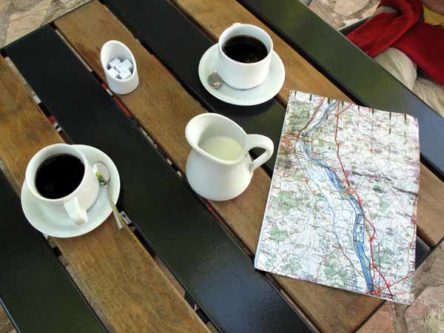
All was not lost however. We saw a sign for a hotel in the village and after thrashing about a bit, and being helped by a passing local, we found it further along the highway, in a walled garden.
In the garden a couple were drinking coffee under a tree, and the woman came over to us. She was pregnant and although not pretty, her face had the appealing simplicity of an early Renaissance Madonna. She brought us coffee and as we drank it we could see the canal over the garden wall.
This was the Lateral Canal of the Loire, the same one that we had followed in the other direction on our previous walk. We never fail to be amazed at the industry and determination of the eighteenth-century workers who had brought the canal system into being with nothing more than horses and shovels.

Revived, as usual out of all proportion to the modest refreshment we had taken, we stepped out onto the highway and found ourselves on the GR31, then lost it immediately after we crossed the canal.
We had assumed it would go along the lovely shady towpath, labelled with “La Loire à Vélo” signs, but in fact the GR went off through the hot open fields and we never saw it again until the end of the day.
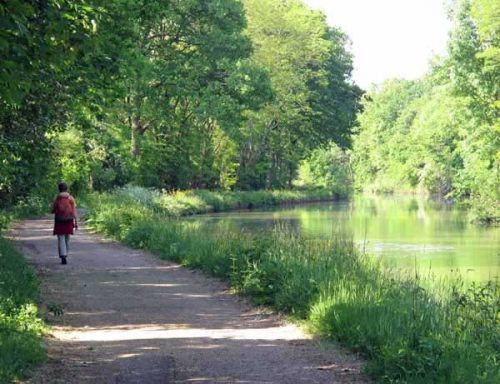
Another hour and a half of pleasant walking beside the canal took us to Saint-Satur.
We had realised by then that if we wanted to visit Sancerre, we would do better to stop at the camping ground of Saint-Satur and make a side trip without our packs, rather than press on to Pouilly for the night.
Sancerre looked a rather strenuous prospect, away on its high dome, and anyway, we were still suffering from jet lag after the long flight from Australia.
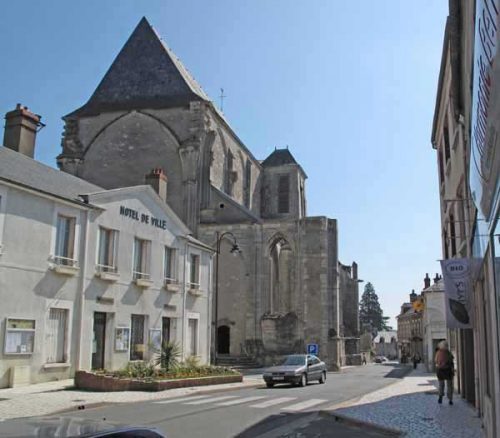
We went over the canal bridge and up into the village, making sure as we passed the Office of Tourism that the camping ground was operating.
The main street had a kink in it as it edged past the majestic bulk of the church, which was jammed between houses on both sides.
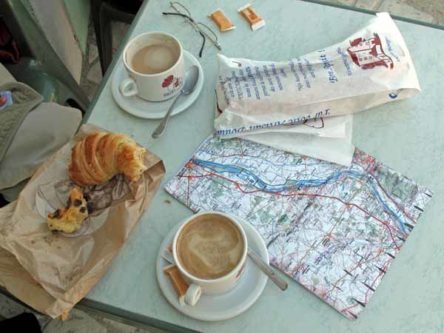
Further along, the street passed under an impressively tall arched viaduct whose purpose we did not know at the time.
We sat at a corner bar in the shade for our second coffee break of the morning, this time accompanied by pastries. Already we had settled into our usual pattern of a croissant for me and a pain aux raisins for Keith.
The camping ground was on the banks of the Loire, back over the canal in the area known as Saint-Thibault. To our surprise, there were four or five promising-looking restaurants along the road, whereas Saint-Satur itself had had little to offer.

At the camping ground everything was spick and span, and we found a lovely place close to the river, with a gate in the fence leading out to the public path, where a line of seats faced the water.
Although we had not walked far, nor sweated much, midday showers were delightful and afterwards we lay on our mats having lunch – fresh bread, goat’s cheese and tomatoes.
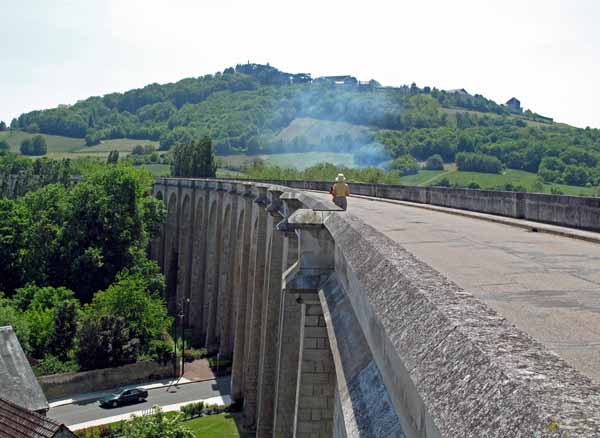
With our washing hung out in the sunshine and our packs stuffed inside the tent, we strolled off in sandals to visit Sancerre. This time we took the link canal back to Saint-Satur, instead of the road.
This very short waterway joins the lateral canal to the Loire itself. Many boats were moored along it, some with heavy, immovable gangways and flower gardens on the nearby bank.
In the village we paid a second visit to the Office of Tourism and they suggested a good walkers’ way to get to Sancerre, using the viaduct we had seen earlier, site of an abandoned railway line, now a small one-way road.
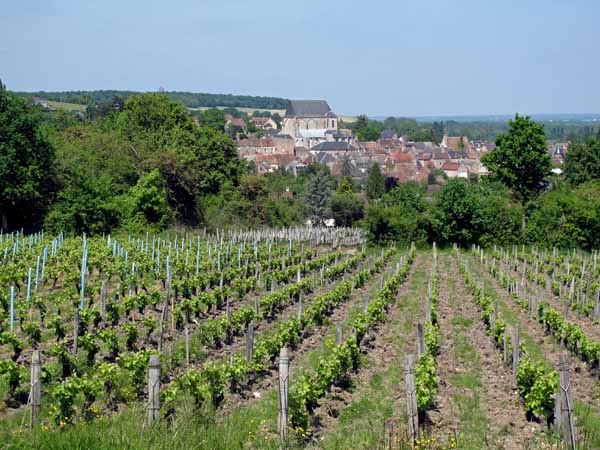
This led us to another little road winding up among vines, and then we found a steep ascending path that took us directly into the streets of the town, not without considerable puffing and panting. It was our first day on the track, after all, and so far we had only been on canals.
Tourists teemed in every corner of the place. We picked up a brochure that guided us past the main features, with the help of a dark-red line painted on the ground. It was the colour of dried blood, which seemed in keeping with the history of the town.
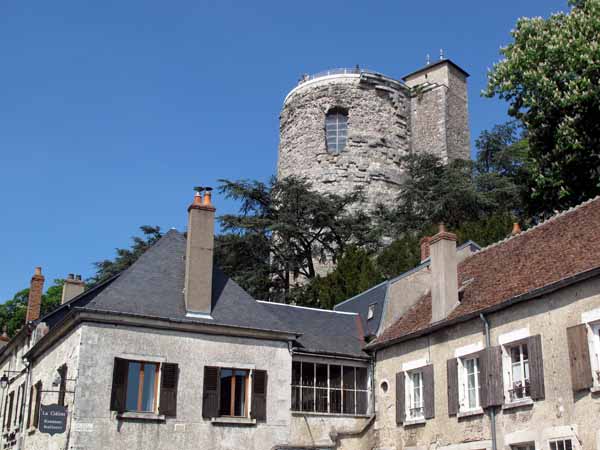
Although Sancerre had repelled attacks by the English during the Hundred Years War, it had been on the wrong side during the Wars of Religion, and had been besieged for eight months, then overrun and severely punished.
The reason that they could last so long was that every house had a well and, although they were a couple of hundred metres above the river, they only needed to dig down ten metres to reach water.
Further on we saw the belfry, sole survivor of the six towers of the now-destroyed château. Both the château and the ramparts were destroyed after the siege on the orders of the king, to prevent further resistance.

To add to the misfortunes of the Sancerrois, they were also briefly on the wrong side in the French Revolution, but they redeemed themselves in the Second World War, being a centre of the Resistance. Their greatest feat was the blowing up of the bridge at Saint-Thibault (near the camping ground) to prevent German troops from crossing the Loire.
At a belvedere near the ruined ramparts there was a wedding in progress, with the backdrop of the rich countryside of the Berry spread out below.
Later, as we wandered through a slit of an alley, an old man beckoned us into his house to see his collection of old farm implements, making us guess what each one was for – we did not do well in this quiz.
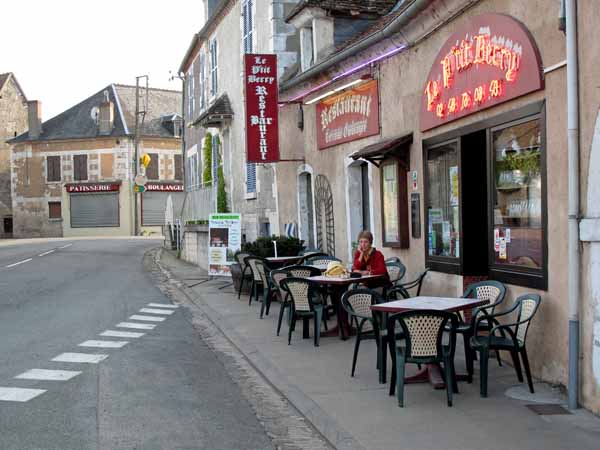
Tired out with tourism, we sat down at an outdoor bar for coffee and cold water. The way back was much shorter than we expected, as we took a plunging, stony path through the vines, then an underpass below the viaduct which led us straight to the lower streets of Saint-Satur.
Back at the camping ground, we found our washing had already dried, so we swapped shirts and washed the ones we had been wearing, hanging them out in the stiff breeze before wandering off to look for dinner.
There was a profusion of choice but we ended up at the P’tit Berry, an old-looking inn with a few tables on the street, a dining room inside and a terrace at the back.
After a glass of rosé in rather spartan conditions outside, we went in to the dining room to eat. Indoors it was cosy, and crowded with locals enjoying Saturday night out.
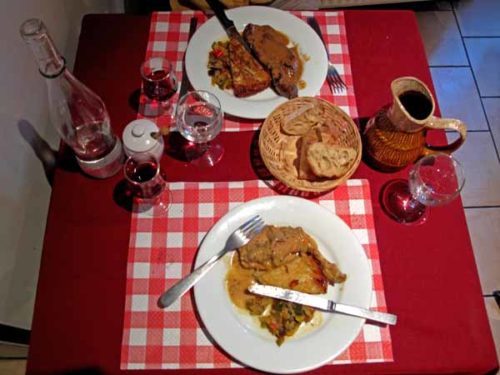
For €13 we had an entrée and a main course. Keith started with a home-made terrine and I had a salad that I had never heard of, which turned out to be several little pastry parcels resting on a salad bed. Both were excellent and we shared them.
We did the same with the rabbit in mustard and the steak with green peppercorns, appreciating the care and love that had gone into the accompaniments – a wedge of grated potato cake and ratatouille.
Very pleased with our first day on the march, we walked the short distance back to our tent. Near us in the camping ground was a couple from Yorkshire, who mentioned that Provence was having torrential rains. That was our first hint of the tragedy that was to occur there later.
Previous section: Clamecy to Cosne-sur-Loire